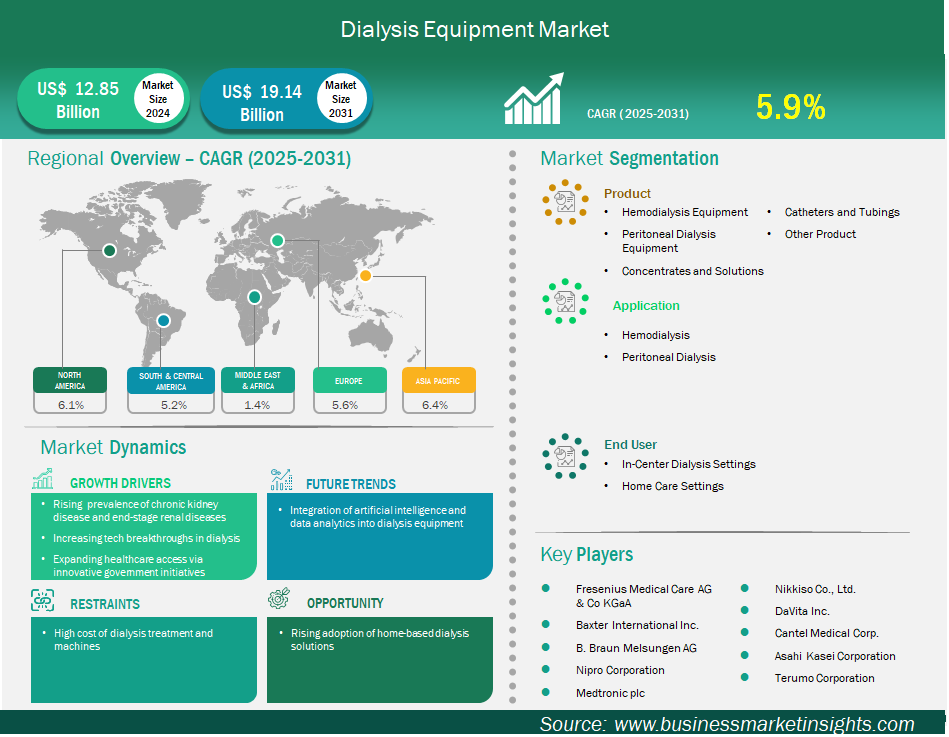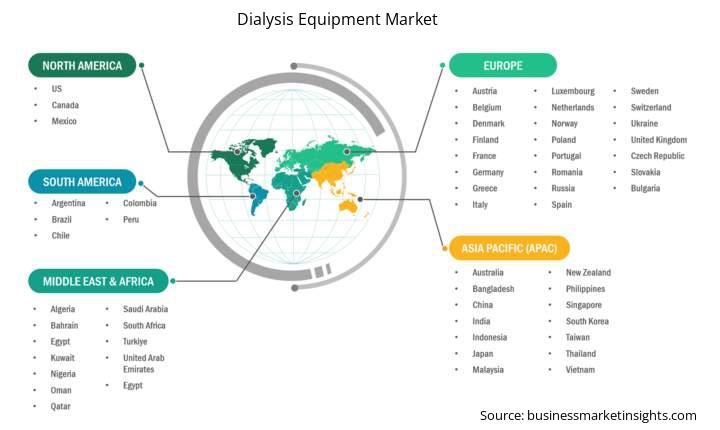Dialysis Equipment Market Outlook (2021-2031)
No. of Pages: 360 | Report Code: BMIPUB00031627 | Category: Life Sciences
No. of Pages: 360 | Report Code: BMIPUB00031627 | Category: Life Sciences
The dialysis equipment market size is expected to reach US$ 19,135.73 million by 2031 from US$ 12,846.81 million in 2024. The market is estimated to record a CAGR of 5.9% from 2025 to 2031.
The global dialysis equipment market is experiencing significant growth driven by rising prevalence of chronic kidney diseases and end-stage renal diseases, increasing tech breakthroughs in dialysis, and expanding healthcare access via innovative government initiatives. Dialysis equipment encompasses hemodialysis equipment, peritoneal dialysis equipment, concentrates and solutions, catheters and tubings, and other products. With the demand for home-based dialysis solutions skyrocketing, manufacturers are coming up with advanced portable dialysis machines and AI-driven monitoring systems to enhance patient convenience and treatment efficiency. Thus, the future of the global dialysis equipment market lies in technological integration, AI-assisted treatment protocols, and expanding home dialysis solutions, making renal care more accessible and efficient while improving patient outcomes worldwide.
One of the primary drivers of the market is the rising prevalence of chronic kidney diseases and end-stage renal diseases. With the rise in chronic kidney diseases and end-stage renal diseases cases, there is an increasing need for dialysis. The burden is particularly high in regions with aging populations and rising incidences of diabetes and hypertension, which are leading causes of kidney failure. Therefore, the growing burden of kidney-related diseases drives the dialysis market. Similarly, the increasing tech breakthroughs in dialysis, is another key contributor to rising demand for dialysis equipment.

Key segments that contributed to the derivation of the dialysis equipment market analysis are product, application, and end user.
Chronic kidney disease (CKD) affects roughly 850 million people around the world, and about 10% of the population globally will face some form of kidney disease. The burden of CKD is large, especially in cases with older populations and rising diabetes and hypertension incidences—these diseases are primary contributors to kidney failure. In the United States (US), there are approximately 37 million adults with CKD, with over 800,000 adults currently living with end-stage renal disease (ESRD), and need either dialysis or kidney transplantation. In China, the prevalence of CKD is estimated between 10% and 12%, totalling over 120 million people, and in India, there are approximately 1.75 million patients who require dialysis each year.
The situation is equally stark in Europe, with over 546,000 patients receiving renal replacement therapy, and Portugal and Belgium having some of the highest rates for dialysis incidence. CKD is on the rise in the Middle East and North Africa (MENA) region, as well, with approximately 73 million adults currently suffering from diabetes (a significant risk factor for kidney disease). This number is estimated to rise to 136 million adults with diabetes in 2045. As CKD progresses to ESRD, patients require lifelong dialysis treatments, increasing the demand for hemodialysis (HD) and peritoneal dialysis (PD) machines, along with essential consumables such as dialyzers, tubing, and catheters. The shift toward home-based dialysis solutions enables patients to seek more convenient and cost-effective treatment options. Additionally, government healthcare initiatives and insurance coverage expansions in Brazil, Saudi Arabia, and South Korea are improving dialysis accessibility, ensuring that more patients receive timely treatment. Thus, the rising disease prevalence, aging demographics, and technological advancements together continue to propel the dialysis equipment market growth, making it a critical segment in global healthcare.
Traditionally, patients received dialysis in hospitals or clinics, necessitating multiple trips in a week for treatment. However, momentum is building towards home-based dialysis (HBD), with home hemodialysis (HHD) and automated peritoneal dialysis (APO), as it's been shown to not only improve quality of life but reduce strain on the healthcare system. In the United States, approximately 14% of dialysis patients choose home-based treatments, and that number is expected to expand with technology and reimbursement practices.
Canada and Australia have also adopted home dialysis programs that government agencies have supported to allow patients to thrive independently. The advancement of dialysis using portable, wearable devices 15, which allows patients to receive treatment at different locations, has been a huge boon and a big reason for the growth of HBD. Real-time monitoring devices using artificial intelligence (i.e., AI integrated into home dialysis machines) have allowed for better monitoring of patients' health, reduced complications, and reduced hospital visits. As policymakers and healthcare providers continue to focus on cost-effective and patient-centered care, the home dialysis 15 section represents a huge growth potential area for manufacturers of home dialysis solutions, and added impetus to continue developing and innovating compact, intuitive, and automated products for dialysis patients.
The dialysis equipment market is classified according to products into hemodialysis equipment, peritoneal dialysis equipment, concentrates and solutions, catheters and tubings, and other products. The hemodialysis equipment segment led the market in 2024 and beyond. Hemodialysis refers to the removal of waste products, excess toxic substances, and excess fluid from the blood when the kidneys can no longer remove them from the blood. The hemodialysis equipment market is growing due to the increasing prevalence of kidney diseases, more healthcare investments, and advancements in the technology of dialysis systems. Hemodialysis equipment consists of several essential components such as dialysis machines, dialyzers (artificial kidneys), bloodlines, dialysate solutions, and vascular access devices.
In terms of applications, the market is segmented into hemodialysis and peritoneal dialysis. The hemodialysis segment had the largest market share in 2024. The market for hemodialysis is expected to continue to grow at varying rates due to developments in treatment modalities, raised awareness for kidney diseases, and supportive governmental policies that are expected to drive growth in a future environment. There is a growing need for tailored dialysis solutions and this includes features such as Al-driven treatment adjustments, which improve patient outcomes and reduce complications.
By end user, the market is segmented into in-center dialysis settings, and home care settings. The in-center dialysis settings segment held the largest share of the market in 2024. In-center dialysis settings serve as the primary treatment environment for patients with ESRD. These settings encompass hospital-based units and specialized dialysis clinics equipped with advanced hemodialysis machines, dialyzers, water treatment systems, and patient monitoring technologies. Market growth is driven by the increasing prevalence of CKD, advancements in dialysis technology, and expanding healthcare infrastructure.
| Report Attribute | Details |
|---|---|
| Market size in 2024 | US$ 12,846.81 Million |
| Market Size by 2031 | US$ 19,135.73 Million |
| Global CAGR (2025 - 2031) | 5.9% |
| Historical Data | 2021-2023 |
| Forecast period | 2025-2031 |
| Segments Covered |
By Product
|
| Regions and Countries Covered | North America
|
| Market leaders and key company profiles |
|
The "Dialysis Equipment Market Size and Forecast (2021–2031)" report provides a detailed analysis of the market covering below areas:

The geographical scope of the dialysis equipment market report is divided into five regions: North America, Asia Pacific, Europe, Middle East & Africa, and South & Central America. The dialysis equipment market in Asia Pacific is expected to grow significantly during the forecast period.
The Asia Pacific dialysis equipment market consists of China, Japan, India, South Korea, Australia, Bangladesh, New Zealand, Philippines, Singapore, Indonesia, Taiwan, Malaysia, Vietnam, and the Rest of Asia Pacific. Countries like Japan, China and India all have increasing cases of CKD, contributing to an increase in demand for dialysis. Japan, with an older population than most countries, has a larger patient base requiring dialysis. In Japan, over 340,000 people are undergoing dialysis. At the same time, China's prevalence of CKD is quickly increasing, with an estimated 120 million individuals affected, with dialysis sometimes more accessible in urban regions compared to rural regions. India, which has a growing burden of CKD, has —1.75 million patients that require dialysis per year and the government has been improving dialysis accessibility through different subsidized plans. The region is also advancing in new technologies, including increased use of portable dialysis machines, automated peritoneal dialysis (APO) and Al monitoring systems to improve treatment efficacy and comfort for patients. Governments and development in healthcare through investment in health care is an important contributor to the growth of the market. Countries like Australia and South Korea, are improving accessibility of dialysis through insurance coverage or public health care programs. Also, more health care resources are available, with medical tourism for CKD in countries like Thailand and Malaysia have fuelled the demand for modern dialysis facilities, attracting international patients seeking specialized renal care. Collaborations between global medical device companies and local manufacturers are further driving innovation, leading to the introduction of cost-effective dialysis solutions tailored to regional needs. The combination of economic growth, increasing healthcare spending, and demographic shifts continues to propel the dialysis equipment market forward, making Asia Pacific one of the fastest-growing regions in the global dialysis industry.
The dialysis equipment market is evaluated by gathering qualitative and quantitative data post primary and secondary research, which includes important corporate publications, association data, and databases. A few of the key developments in the dialysis equipment market are:
The Dialysis Equipment Market is valued at US$ 12,846.81 Million in 2024, it is projected to reach US$ 19,135.73 Million by 2031.
As per our report Dialysis Equipment Market, the market size is valued at US$ 12,846.81 Million in 2024, projecting it to reach US$ 19,135.73 Million by 2031. This translates to a CAGR of approximately 5.9% during the forecast period.
The Dialysis Equipment Market report typically cover these key segments-
The historic period, base year, and forecast period can vary slightly depending on the specific market research report. However, for the Dialysis Equipment Market report:
The Dialysis Equipment Market is populated by several key players, each contributing to its growth and innovation. Some of the major players include:
The Dialysis Equipment Market report is valuable for diverse stakeholders, including:
Essentially, anyone involved in or considering involvement in the Dialysis Equipment Market value chain can benefit from the information contained in a comprehensive market report.